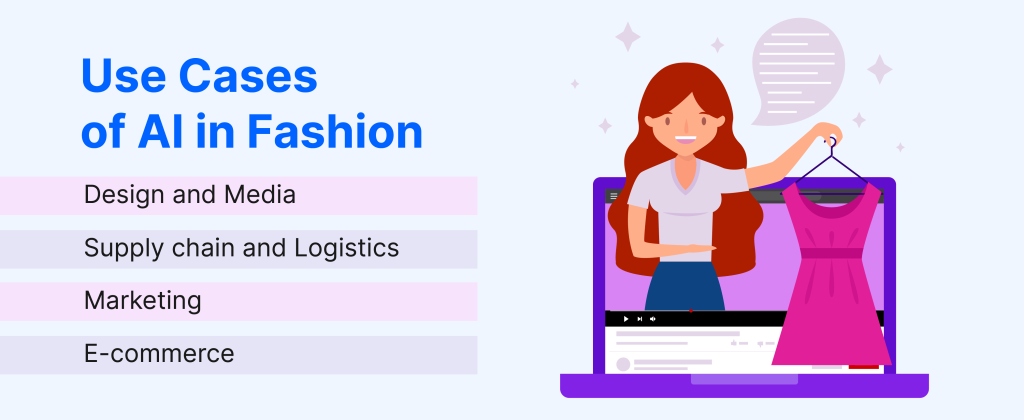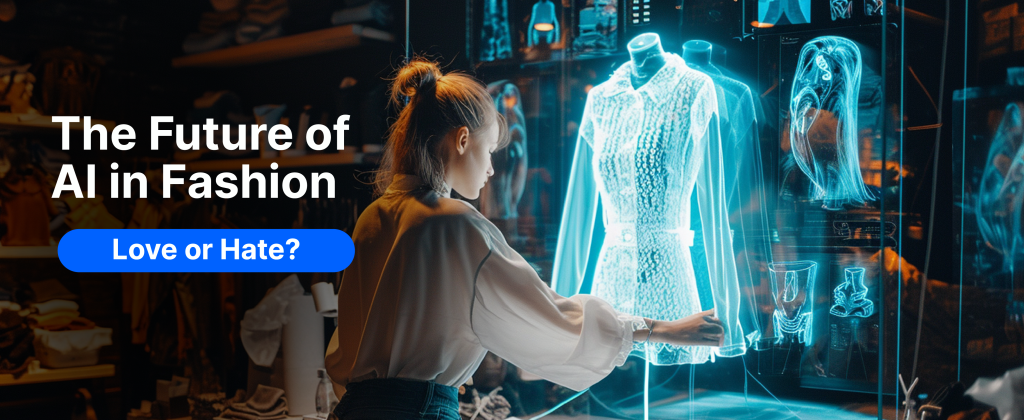When teams operate independently, it creates communication gaps that can lead to disorder. In contrast, when teams collaborate, they tend to be more efficient.
Have you seen the Vogue headline about AI Fashion Week in London, Milan, New York and Paris? It was “What to expect at the first AI Fashion Week” It sparked curiosity: are we truly living in an AI-infused world, or is that the future we’re heading for? For example, what exactly is the AI Fashion Week? How will AI and fashion interact in the coming years?
Significantly, Generative AI is making its footprints in every industry. According to a McKinsey analysis, generative AI could boost operating profits in the apparel, fashion, and luxury sectors by $150 billion, and possibly up to $275 billion, over the next three to five years. This justifies that the enormous economic potential is huge if we incorporate advanced ai for the fashion design industry. It is not only about automation but also the augmentation and acceleration of creative and production processes.
Unfamiliar with all of this? Let’s clear some buzzphrases before we get into the formal definitions of data science, artificial intelligence, and machine learning. Data science will provide you with insights, machine learning will use algorithms to make predictions, and artificial intelligence will handle the actual actions, such as self-driving cars. So, without further ado, let us get into this article.
AI clothing is changing how we think of fashion yesterday. Today AI changes everything from design to marketing and sales, it offers businesses new opportunities to streamline their operations and reach new heights. The impact of AI for the fashion industry has many use cases and applications. Let’s take a closer look at the use cases and applications of AI in fashion and what they mean for the industry as a whole.

AI is revolutionizing the fashion industry by enhancing supply chain management, reducing costs, and promoting sustainability. Businesses can train AI models to predict future sales and demand for more AI-based decisions about stocking, overproduction and when to reduce waste. It helps improve customer satisfaction and increase profits.
AI fashion app design systems can also manage logistics by tracking and analyzing shipping data which helps in ensuring efficient product delivery and reducing carbon footprint. Here are some examples:
AI clothing aids in sourcing raw materials by helping designers and manufacturers find sustainable alternatives. It is visible how AI is becoming an indispensable tool in optimizing supply chains, reducing costs, enhancing efficiency, and promoting sustainability in the fashion industry.
AI in fashion business integration saves time and money. Businesses that already leveraged AI generated clothing are at the edge of the curve. They can identify emerging markets using AI. However, AI and fashion fusion in marketing offer a new level of personalization and efficiency which enable businesses to reach new customers and generate more sales. If integrated into clothing brands, it can increase customer engagement and boost sales. It can help fashion businesses predict future customer behavior based on past data, allowing brands to anticipate customer needs and market their products accordingly.
AI apparel can manage programmatic advertising, automatically purchasing ad space in real-time, targeting specific customer segments and optimizing ad spend. This can drive engagement, conversions, and brand loyalty, maximizing ROI. AI-powered chatbots can interact with customers, answering queries and providing personalized recommendations, enhancing the shopping experience and customer engagement.
There are some real-world examples of AI in fashion including Tommy Hilfiger AI for Fashion Launch. They collaborate with IBM and the Fashion Institute of Technology to analyze fashion data. This data helps to design new collections and create targeted marketing campaigns. This way, AI is redefining fashion marketing by providing brands with a powerful tool to engage with customers in a personalized, efficient, and impactful manner.
In e-commerce, personalization is an important factor for retailers. AI and fashion ecommerce are playing a significant role in personalizing the shopping experience for customers. Fashion brands provide personalized recommendations based on individual customer behavior, preferences, and shopping history using AI. Amazon, Alibaba, and other small and medium-sized fashion businesses are all leveraging AI to personalize their offerings.
Amazon uses AI to offer product recommendations, helping customers discover new items that align with their style and needs. However, Alibaba’s FashionAI technology provides personalized mix-and-match recommendations in physical stores, creating a seamless and engaging shopping experience across online and offline platforms. This means using AI can enhance the shopping journey of customers by driving customer loyalty and boosting sales in the increasingly competitive fashion market.
AI in the media industry transforms the design process in fashion. It helps by predicting trends and analyzing customer preferences. It allows businesses to create popular designs and reduces the risk of non-sold items. AI in fashion opens up new opportunities for innovative, market-driven media and designs. However, there are also challenges to consider when implementing AI in fashion.
Integrating AI into the fashion industry comes with numerous advantages like enhanced data analysis and innovative design processes. Businesses and industries that are looking to integrate AI into clothing brands must address challenges to ensure a balanced and thoughtful adoption.
AI can perform tasks that were traditionally done by designers, marketers, content writers, developers, and fashion professionals. There is a fear in the job market that AI will displace human jobs. Experts predict that it could impact the broader economic health of the fashion industry. Businesses need to navigate this transition responsibly, looking for ways to augment human work with AI rather than simply replacing it with AI. It requires retraining and upskilling employees as a viable strategy to address this challenge.
AI cannot work extraordinarily without human collaboration. AI-driven design and marketing might lead to a homogenization of fashion. It means Artificial intelligence costumes or AI clothing styles can be less unique, repetitive and less creative. The fashion industry should not completely rely on algorithms that will reduce the quality of design and diversity of products. The fashion industry must integrate AI in ways that enhance creativity rather than constrain it. Businesses can encourage AI systems to learn from a broad and diverse dataset provided by humans will help mitigate the risk of less innovation and as a result, will maintain the vibrant diversity that fashion thrives on.
As fashion businesses increasingly utilize AI in their stores, fashion weeks and apparel, retailers need to rethink data privacy and algorithmic bias seriously. Companies should make fair use of customers’ data, especially as consumers become more aware and proactive about their privacy rights. It is important to ensure transparency and accountability in the use of AI tools is essential. Retailers must prioritize these things to protect users’ biometric information.

The biggest concern is that AI algorithms will eventually replace humans. The answer is no. As a powerful tool, it can do amazing things, but only if it is used correctly by someone who understands AI – Humans. AI can quickly process large datasets, identify emerging trends, and recommend innovative design elements. However, human designers bring a level of emotional intelligence, cultural awareness, and understanding of the human experience that AI cannot match.
When AI and humans collaborate – creativity works together and the result is a reflection of that symbiotic relationship that pushes the boundaries of innovation. AI helps provide new perspectives that human designers may miss when working alone and brainstorming ideas. On the other hand, human designers refine the ideas and concepts of AI with their distinct perspectives that transcend algorithms and data.
The fashion industry is creative and without innovations and effective practices, it cannot go forward. With the rise of AI in fashion, competition gets high. Businesses that utilize AI can thrive in the technological-driven world. At IntelliCoworks, we understand the transformative power of AI from design and production to marketing and e-commerce. Our AI development services can help brands anticipate market trends, enhance customer experiences, and achieve unprecedented operational efficiency. We believe that the future of AI in fashion is not just about automating processes but enriching them. We help brands thrive with creativity and precision. As an AI development company, we don’t think of a brand as a participant but as a leader in the AI-infused fashion future.
In summary, AI has the potential to transform the fashion industry but it also introduces new challenges that businesses must address. However, the advantages and disadvantages of AI in fashion are entirely subjective. The key to successful integration lies in using AI as a tool to complement human skills and creativity, ensuring it adds value without undermining the essence of the fashion industry.
Ready to Integrate AI Solutions to Optimize Your Fashion Business?

Talk to us and let’s build something great together
A Subsidiary of Vaival Technologies, LLC
IntelliCoworks is a leading DevOps, SecOps and DataOps service provider and specializes in delivering tailored solutions using the latest technologies to serve various industries. Our DevOps engineers help companies with the endless process of securing both data and operations.
Ops
Cloud
AI & ML
Copyrights © 2023 byIntellicoworks. All rights reserved.